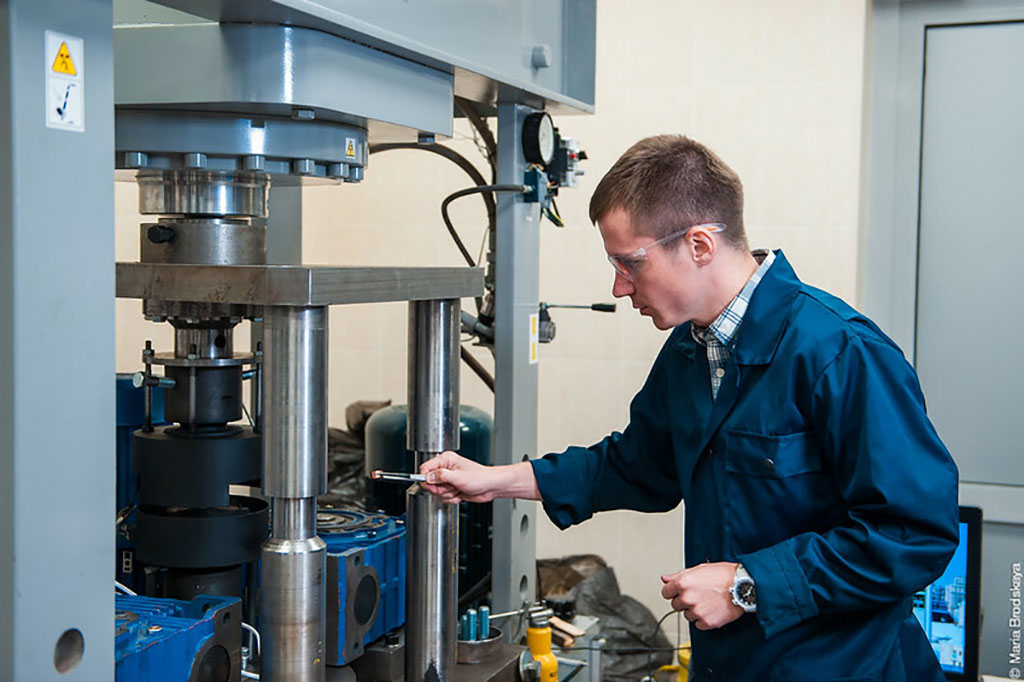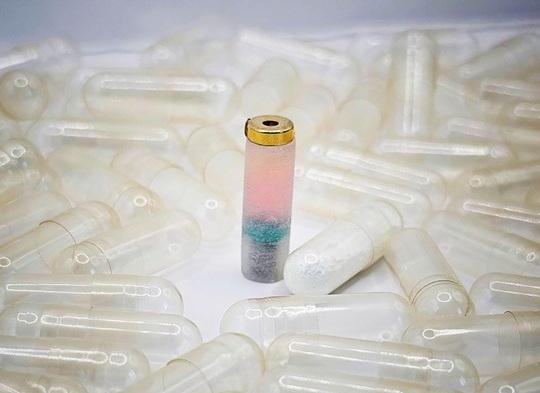Innovative Biodegradable Alloy Advances Bone Implants
|
By HospiMedica International staff writers Posted on 16 Jul 2020 |

Image: Dr. Alexander Komissarov testing the magnesium, gallium, and zinc alloy (Photo courtesy of NUST-MISiS)
A new bioresorbable alloy based on magnesium, gallium, and zinc can be used to make temporary implants for the treatment of fractures, osteoporosis, and myeloma.
Developed at the Russian National University of Science and Technology (NUST-MISiS; Moscow, Russia), Monash University (Melbourne, Australia), and other institutions, the new bioresorbable alloy takes advantage of the efficacy of gallium in inhibiting bone resorption, osteoporosis, Paget's disease, and other illnesses. The alloy is intended for use in the manufacture of temporary implants for the treatment of fractures, and the restoration of surgically removed bone due to pathologies.
A severe plastic deformation technique of equal channel angular pressing (ECAP) provides the alloy with favorable mechanical properties and a low rate of degradation and biocorrosion, in contrast to alloys that are based largely on magnesium. As result, it does not undergo a rapid decomposition process in the environment of the human body, and retains its supporting functions throughout the healing process. The study was published on May 12, 2020, in the Journal of Magnesium and Alloys.
“Gallium is known as an ‘inhibitor’ of bone resorption, it is effective in treating disorders associated with accelerated bone loss,” said Alexander Komissarov, PhD, head of the Hybrid Nanostructured Materials Laboratory at NUST MISIS. “Gallium is also involved in biochemical regeneration processes, increasing the thickness, strength, and mineral content of the bone. Finally, it has an antibacterial effect, which is especially important in implantology.”
Gallium is predominantly used in electronics. And although gallium it has no natural function in biology, gallium ions interact with processes in the body in a manner similar to iron (Fe). The body therefore handles Gallium as though it were Fe3+, and the ion is bound in areas of inflammation, such as infection, and in areas of rapid cell division. It is also used in nuclear medicine imaging radiopharmaceutical agents (Gallium scan), such as the radioactive isotope 67Ga.
Related Links:
Russian National University of Science and Technology
Monash University
Developed at the Russian National University of Science and Technology (NUST-MISiS; Moscow, Russia), Monash University (Melbourne, Australia), and other institutions, the new bioresorbable alloy takes advantage of the efficacy of gallium in inhibiting bone resorption, osteoporosis, Paget's disease, and other illnesses. The alloy is intended for use in the manufacture of temporary implants for the treatment of fractures, and the restoration of surgically removed bone due to pathologies.
A severe plastic deformation technique of equal channel angular pressing (ECAP) provides the alloy with favorable mechanical properties and a low rate of degradation and biocorrosion, in contrast to alloys that are based largely on magnesium. As result, it does not undergo a rapid decomposition process in the environment of the human body, and retains its supporting functions throughout the healing process. The study was published on May 12, 2020, in the Journal of Magnesium and Alloys.
“Gallium is known as an ‘inhibitor’ of bone resorption, it is effective in treating disorders associated with accelerated bone loss,” said Alexander Komissarov, PhD, head of the Hybrid Nanostructured Materials Laboratory at NUST MISIS. “Gallium is also involved in biochemical regeneration processes, increasing the thickness, strength, and mineral content of the bone. Finally, it has an antibacterial effect, which is especially important in implantology.”
Gallium is predominantly used in electronics. And although gallium it has no natural function in biology, gallium ions interact with processes in the body in a manner similar to iron (Fe). The body therefore handles Gallium as though it were Fe3+, and the ion is bound in areas of inflammation, such as infection, and in areas of rapid cell division. It is also used in nuclear medicine imaging radiopharmaceutical agents (Gallium scan), such as the radioactive isotope 67Ga.
Related Links:
Russian National University of Science and Technology
Monash University
Latest Surgical Techniques News
- Minimally Invasive Endoscopic Surgery Improves Severe Stroke Outcomes
- Novel Glue Prevents Complications After Breast Cancer Surgery
- Breakthrough Brain Implant Enables Safer and More Precise Drug Delivery
- Bioadhesive Sponge Stops Uncontrolled Internal Bleeding During Surgery
- Revolutionary Nano Bone Material to Accelerate Surgery and Healing
- Superior Orthopedic Implants Combat Infections and Quicken Healing After Surgery
- Laser-Based Technique Eliminates Pancreatic Tumors While Protecting Healthy Tissue
- Surgical Treatment of Severe Carotid Artery Stenosis Benefits Blood-Brain Barrier
- Revolutionary Reusable Duodenoscope Introduces 68-Minute Sterilization
- World's First Transcatheter Smart Implant Monitors and Treats Congestion in Heart Failure
- Hybrid Endoscope Marks Breakthrough in Surgical Visualization
- Robot-Assisted Bronchoscope Diagnoses Tiniest and Hardest to Reach Lung Tumors
- Diamond-Titanium Device Paves Way for Smart Implants that Warn of Disease Progression
- 3D Printable Bio-Active Glass Could Serve as Bone Replacement Material
- Spider-Inspired Magnetic Soft Robots to Perform Minimally Invasive GI Tract Procedures
- Micro Imaging Device Paired with Endoscope Spots Cancers at Earlier Stage
Channels
Critical Care
view channel
AI Heart Attack Risk Assessment Tool Outperforms Existing Methods
For decades, doctors have relied on standardized scoring systems to assess patients with the most common type of heart attack—non-ST-elevation acute coronary syndrome (NSTE-ACS). The GRACE score, used... Read more
'Universal' Kidney to Match Any Blood Type
Blood-type incompatibility has long been one of the greatest obstacles in organ transplantation, forcing thousands of patients—particularly those with type O blood—to wait years longer for compatible donors.... Read morePatient Care
view channel
Revolutionary Automatic IV-Line Flushing Device to Enhance Infusion Care
More than 80% of in-hospital patients receive intravenous (IV) therapy. Every dose of IV medicine delivered in a small volume (<250 mL) infusion bag should be followed by subsequent flushing to ensure... Read more
VR Training Tool Combats Contamination of Portable Medical Equipment
Healthcare-associated infections (HAIs) impact one in every 31 patients, cause nearly 100,000 deaths each year, and cost USD 28.4 billion in direct medical expenses. Notably, up to 75% of these infections... Read more
Portable Biosensor Platform to Reduce Hospital-Acquired Infections
Approximately 4 million patients in the European Union acquire healthcare-associated infections (HAIs) or nosocomial infections each year, with around 37,000 deaths directly resulting from these infections,... Read moreFirst-Of-Its-Kind Portable Germicidal Light Technology Disinfects High-Touch Clinical Surfaces in Seconds
Reducing healthcare-acquired infections (HAIs) remains a pressing issue within global healthcare systems. In the United States alone, 1.7 million patients contract HAIs annually, leading to approximately... Read moreHealth IT
view channel
Printable Molecule-Selective Nanoparticles Enable Mass Production of Wearable Biosensors
The future of medicine is likely to focus on the personalization of healthcare—understanding exactly what an individual requires and delivering the appropriate combination of nutrients, metabolites, and... Read moreBusiness
view channel
Philips and Masimo Partner to Advance Patient Monitoring Measurement Technologies
Royal Philips (Amsterdam, Netherlands) and Masimo (Irvine, California, USA) have renewed their multi-year strategic collaboration, combining Philips’ expertise in patient monitoring with Masimo’s noninvasive... Read more
B. Braun Acquires Digital Microsurgery Company True Digital Surgery
The high-end microsurgery market in neurosurgery, spine, and ENT is undergoing a significant transformation. Traditional analog microscopes are giving way to digital exoscopes, which provide improved visualization,... Read more
CMEF 2025 to Promote Holistic and High-Quality Development of Medical and Health Industry
The 92nd China International Medical Equipment Fair (CMEF 2025) Autumn Exhibition is scheduled to be held from September 26 to 29 at the China Import and Export Fair Complex (Canton Fair Complex) in Guangzhou.... Read more













